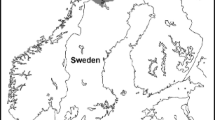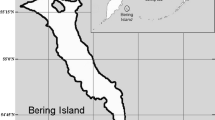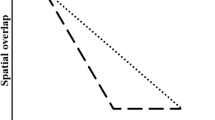Abstract
Spatial organization of the red fox (Vulpes vulpes schrencki) was investigated on the basis of seasonal food distribution in the Shiretoko National Park, Hokkaido from 1992 to 1994. Four periods were recorded pertaining to the distribution of 2 kinds of food resources: human food and spawning salmonid carcasses. The home range utilizations of radio-collared foxes were compared for the periods. In the periods when food was not spatially concentrated, resident foxes were territorial, showing exclusive distribution of home ranges between families, defense against intruding foxes at the edge of home ranges, and site specific dominance over intruding foxes. In contrast, during periods when food distribution was concentrated, home ranges overlapped. In the latter periods, foxes made round trips of up to 8 km from their territories to the localized concentration of food, the distance that foxes can travel within a day. This suggests that red foxes in this area have unique foraging ranges that include some seasonally available food outside their territories, and that these ranges depend on fluctuating food distribution caused by humans.
Similar content being viewed by others
References
Calisti, M., B. Ciampalini, S. Lovari & M. Lucherini 1990 Food habits and trophic niche variation of the red foxVulpes vulpes (L., 1758) in a Mediterranean coastal area.Rev. Ecol. 45: 309–320.
Carr, G. & D.W. Macdonald 1986 The sociality of solitary foragers: a model based on resource dispersion.Anim. Behav. 34: 1540–1549.
Cavallini, P. & S. Lovari 1991 Environmental factors influencing the use of habitat in the red fox,Vulpes vulpes.J. Zool., Lond. 223: 323–339.
Davies, N.D. & A.I. Houston 1981 Owners and satellites: the economics of territory defense in the pied wagtail,Motacilla alba.J. Anim. Ecol. 50: 157–180.
Davies, N.D. & A.I. Houston 1983 Time allocation between territories and flocks and owner-satellite conflict in foraging pied wagtails,Motacilla alba.J. Anim. Ecol. 52: 621–634.
Doncaster C.P. 1990 Non-parametric estimates of interaction from radio-tracking data.J. Theor. Biol. 143: 431–443.
Doncaster, C.P., C.R. Dickman & D.W. Macdonald 1990 Feeding ecology of red foxes (Vulpes vulpeshs) in the city of Oxford, England.J. Mamm. 71: 188–194.
Doncaster C.P. & D.W. Macdonald 1991 Drifting territoriality in the red foxVulpes vulpes.J. Anim. Ecol. 60: 423–439.
Goszczyñski, J. 1989 Spatial distribution of red foxesVulpes vulpes in winter.Acta Theriol. 34: 361–372.
Hofer, H. & M.L. East 1993a The commuting systems of Serengeti spotted hyaenas: how a predator copes with migratory prey. I. Social organization.Anim. Behav. 46: 547–557.
Hofer, H. & M.L. East 1993b The commuting systems of Serengeti spotted hyaenas: how a predator copes with migratory prey. II. Intrusion pressure and commutres’ space use.Anim. Behav. 46: 559–574.
Hofer, H. & M.L. East 1993c The commuting systems of Serengeti spotted hyaenas: how a predator copes with migratory prey. III. Attendance and maternal care.Anim. Behav. 46: 575–589.
Knick, S.T. 1990 Ecology of bobcats relative to exploitation and a prey decline in southeastern Idaho.Wildl. Monogr. 108: 1–42.
Kolb, H.H. 1984 Factors affecting the movements of dog foxes in Edinburgh.J. Appl. Ecol. 21: 161–173.
Krebs, J.R. 1982 Territorial defense in the great tit,Parus maior: do residents always win?Behav. Ecol. Sociobiol. 11: 185–194.
Kruuk, H. & D.W. Macdonald 1985 Group territories of carnivores: empires and enclaves. In: R.M. Sibly & R.H. Smith (eds.)Behavioral ecology: ecological consequence of adaptive behaviour. Blackwell Scientific Publications, Oxford. pp.521–536.
Kruuk, H. & T. Parish 1982 Factors affecting population density, group size and territory size of the European badger,Meles meles.J. Zool., Lond. 196: 31–39.
Macdonald, D.W. 1981 Resource dispersion and the social organization of the red fox (Vulpes vulpes). In: J.A. Chapman & D. Pursley (eds.)Worldwide furbearer conference proceedings vol. 2. University of Maryland Press, Maryland. pp.918–949.
Macdonald, D.W. 1983 The ecology of carnivore social behaviour.Nature 301: 379–384.
Maher, C.R. & D.F. Lott 1995 Definitions of territoriality used in the study of variation in vertebrate spacing systems.Anim. Behav. 49: 1581–1597.
Messier, F. 1985 Solitary living and extraterritorial movements of wolves in relation to social status and prey abundance.Can. J. Zool. 63: 239–245.
Mills, M.G.L. 1982 Factors affecting group size and territory size of the Brown hyaena,Hyaena brunnea.J. Zool., Lond. 198: 39–51.
Murder, J. L. 1985 Spatial organization, movements and dispersal in a Dutch red fox (Vulpes vulpes) population: some preliminary results.Rev. Ecol. 40: 133–138.
Niewold, F.J.J. 1974 Irregular movements of the red fox (Vulpes vulpes) determined by radio tracking.Trans. Int. Congr. Game Biol. 11: 1–8.
Niewold, F.J.J. 1980 Aspects of the social structure of red fox populations: a summary. In: E. Zimen (ed.)Biogeographica 18: red fox. Dr. W. Junnk bv Publishers, The Hague. pp.185–193.
von Schantz, T. 1984 Spacing strategies, kin selection and population regulation in altricial vertebrates.Oikos 42: 59–65.
Storm, G.L., R.D. Andrews, R.L. Phillips, R.A. Bishop, D.B. Siniff & J.R. Tester 1976 Morphology, reproduction, dispersal, and mortality of midwestern red fox population.J. Wildl. Monog. 49: 1–82.
Takeuchi, M. & M. Koganezawa 1992 Home range and habitat utilization of the red foxVulpes vulpes in the Ashio Mountains, central Japan.J. Mamm. Soc. Jap. 17: 95–110
Todd, I.A. 1992WILDTRAK. Non-parametric home range analysis for Macintosh computers. Dept. of Zoology, University of Oxford, Oxford.
Tsukada H. 1994 A study of the ecology of foxes in Shiretoko National Park and their utilization for nature education programs.Bull. Shiretoko Museum 15: 63–82. (in Japanese with English summary).
Tsukada, H. & N. Nonaka (in press) Foraging behavior of red foxes (Vulpes vulpes schrencki) utilizing human food in the Shiretoko National Park.Mammal Study 21.
Voigt, D.R. & D.W. Macdonald 1984 Variation in the spatial and social behaviour of the red fox,Vulpes vulpes.Acta. Zool. Fennica 171: 261–265.
Zimen, E. 1984 Long range movements of the red fox,Vulpes vulpes L.Acta Zool. Fennica 171: 267–270.
Author information
Authors and Affiliations
About this article
Cite this article
Tsukada, H. A division between foraging range and territory related to food distribution in the red fox. J Ethol 15, 27–37 (1997). https://doi.org/10.1007/BF02767323
Received:
Accepted:
Issue Date:
DOI: https://doi.org/10.1007/BF02767323




